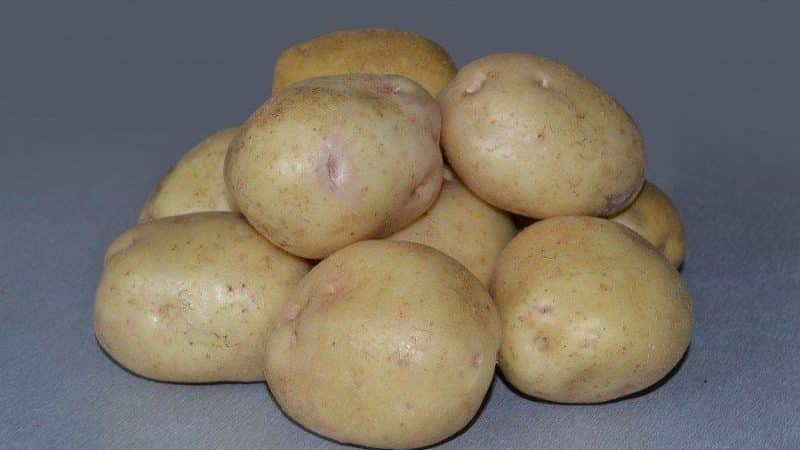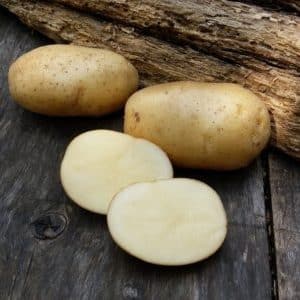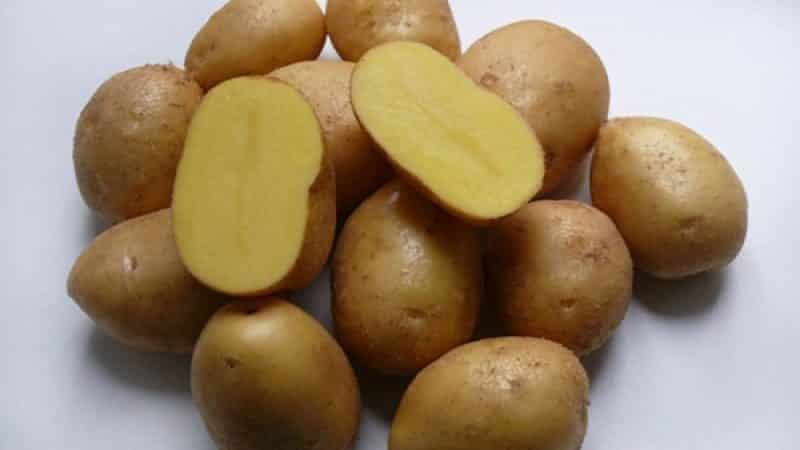An incredible combination of unpretentiousness and productivity of the Nevsky potato variety
An important point when planting potatoes is the choice of variety. We draw your attention to the Nevsky variety, which for several decades has been famous for its ease of care, disease resistance, excellent tuber taste and high yield.
Read our article about how to properly plant Nevsky and care for it.
Description
Potato Nevsky - mid-early variety. It takes 75–90 days from the emergence of seedlings to harvest. This period depends on weather conditions.
Nevsky was bred in 1975 by the Leningrad Research Institute of Agriculture "Belogorka". It was included in the State Register of the Russian Federation in 1982.

Differences from other varieties
The bushes are erect, branched, up to 1 m high. The stems have large dark green leaves. In severe drought, they curl into a tube, thereby reducing moisture evaporation.
The flowers are large and white. The roots are powerful, fibrous, and provide plants with water from deeper layers of the soil.
Compound
Just 100 g of potatoes contain many useful substances:
- vitamin C - 22.2% of the daily value;
- vitamin B6 - 15%;

- vitamin PP - 9%;
- potassium - 22.7%;
- phosphorus - 7.3%;
- magnesium - 5.8%;
- cobalt - 50%;
- chromium - 20%;
- copper - 14%.
Tubers contain digestible carbohydrates, essential and non-essential amino acids, monounsaturated and polyunsaturated fatty acids.
Energy value per 100 g - 77 kcal, carbohydrate content - 16.3 g, fat - 0.4 g, protein - 8 g.
Quantity starch in the pulp - 10.4–14.8%, thanks to this the tubers do not darken during cleaning.
Characteristics of tubers and yield
Nevsky's tubers are round or oval in shape. The peel is white-yellow in color with pinkish eyes. The flesh is beige, dense, without voids.
Reference! The variety is one of the most productive: 400–500 kg of potatoes are harvested from one hundred square meters of land.
15–17 tubers are formed on one bush. The weight of one is 100–150 g. There are also larger ones, up to 200 g.
Regions for cultivation and planting dates
The Nevsky variety is suitable for cultivation in any region of Russia, Ukraine and Moldova.
Planting begins when the soil at a depth of 10–12 cm warms up well. In the southern regions this occurs at the end of April, in places with a temperate climate - in the middle or end of May.
Advantages and disadvantages of the variety
The main advantages of Nevsky potatoes:
- high productivity;
- drought resistance due to a developed root system;
- undemanding to growing conditions;
- attractive presentation and high transportability;
- the ability of the skin to quickly tighten after mechanical damage;
- immunity to some potato diseases;
- quick recovery after an attack by Colorado potato beetles.
Flaws:
- the variety has poor resistance to nematodes and late blight;
- tubers have limited use in cooking, more suitable for soups and salads;
- On acidified soil, the crop produces a weak harvest.
Features of planting and growing
Although the variety is quite unpretentious, it still needs basic care.
Preparing for landing
Nevsky potatoes love warmth, so choose a sunny area for planting. The soil must be loose so that moisture and air can penetrate well. If the soil is depleted, it is fertilized with compost or humus.
Important! They don’t use fresh manure for potatoes: it causes more weeds, pests and diseases to appear.
Before planting, seed potatoes are germinated and then treated with special means.
Germination is carried out 4 weeks before planting:
- They sort through the tubers for seeds and remove spoiled and diseased ones. Vegetables weighing about 80 g are suitable, slightly larger in size than a chicken egg.
- Potatoes are laid out in the sun in a warm room at a temperature of +15°C.
- When the sprouts reach 1 cm, the temperature is reduced to +12°C.
Before planting in the ground, the tubers are treated:
- for growth, use the drug “Poteitin” or “Mikom”;
- to prevent fungal diseases, seeds are placed in a solution of potassium permanganate or boric acid;
- “Maxim” or “Aktofit” products are suitable against pests.
Potatoes are not cut into pieces. It is planted only with whole tubers.
Planting scheme and technology
Potatoes are planted at soil temperatures of +6…+8°C. Planting in cold soil and delaying for several weeks will result in the loss of most of the crop.
Planting pattern:
- Dig holes about 20 cm deep, focusing on the bayonet of the shovel.
- The distance between bushes is about 40 cm, between rows - 60–70 cm. This will make it more convenient to weed and hill up the plantings.
- Fertilizer is placed in the holes: for example, onion peels and wood ash.
- The tubers are placed with the sprouts facing upward and sprinkled with soil on top.
- The soil is leveled with a rake and watered.
For large areas, it is convenient to sow on the eve of rain. The first shoots appear after about 2 weeks.
Features of cultivation
In order for potatoes to please you with a large harvest, it is important to know some of its features:
- The variety prefers moderate drought to excess moisture;
- groundwater on the site should not approach the surface of the earth closer than 1 m;
- The sprouts are easily damaged, so the tubers are planted carefully.
Nevsky has a powerful root system, so it is important to maintain the distance between the bushes.
Nuances of care
Caring for seedlings is not difficult, especially if you have experience. Weeds are removed as they grow. Plantings are regularly hilled, making moderately high hills. This stimulates the appearance of additional stolons on which ovaries are formed.

Watering mode
Water the crop in the evening or morning as needed, monitoring the condition of the soil.
Standard humidification scheme:
- first watering - when planting;
- the second - after the sprouts appear;
- the third - on the eve of flowering;
- the fourth - during the formation of tubers.
In rainy summers, the amount of watering is reduced: the variety does not tolerate excess moisture.
Attention! When irrigating from a hose, it is not directed directly under the bush - it is better to use irrigation based on the sprinkling principle.
In hot weather, the soil is not moistened. This will only worsen the condition of the vegetables.
Top dressing
The variety requires regular fertilization:
- first feeding carried out before the formation of buds, using liquid mullein and urea;
- during the budding period, sodium sulfate and wood ash are added;
- when the plant begins to bloom, add mullein and superphosphate.
The interval between fertilizers is at least 14 days. Be careful with mineral products: they can provoke fungal diseases.
Disease and pest control
The variety is resistant to most potato diseases: it is not afraid of potato cancer and rhizoctonia.
The plant is moderately susceptible to late blight, which is manifested by darkening and curling of the leaves.The disease is practically untreatable, but at the initial stage, a remedy prepared from 1 Trichopolum tablet diluted in 10 liters of water is effective. The solution is sprayed onto the soil and bushes 2 times a month.
Pests affecting the variety:
- Nematode - small worms that live inside tubers. Phosfamide is used against them. Treatment time is 10 days. The concentration of the solution is 0.2%.
- Colorado beetle - eats leaves, as a result the bushes grow poorly and the tubers do not gain weight. For prevention, plants with a specific smell are planted near the beds: basil, parsley, dill. If the variety is nevertheless attacked by beetles, then they are collected manually. Suitable medications include Karate, Bankol or Aktara.
- Medvedka - spoils the tubers by gnawing holes in them. To combat, use a solution of laundry soap at the rate of 2 pieces per bucket of water.
- Wireworm - bites into tubers, making holes in them. To get rid of the pest, prepare the following solution: 15 ml of Actellik is mixed with 80 ml of water and 200 ml of acetone. They cultivate the soil and bushes.
Chemicals are used at least 30 days before digging up potatoes.
Harvest and storage
The harvest begins in August - September. As soon as the leaves dry, the tubers are dug up.
Potatoes are harvested using a pitchfork or mechanized method. The harvested crop is sorted and dried. Spoiled or damaged specimens are sent for food or animal feed.
Important! When storing vegetables, it is important to make sure they are completely dry.
Keep potatoes in a basement or cellar at a temperature of +3 to +5°C and good air circulation. The variety has a high shelf life, so it is able to retain its presentation and taste for a long time. Sprouts appear only in spring.
Difficulties in growing

When growing a variety, some vegetable growers encounter problems:
- potato damage by late blight and pests;
- damage to tender sprouts landing;
The variety is heat-loving; at low temperatures and insufficient light it produces a smaller yield.
Advice from gardeners
To increase productivity, farmers feed the crop with potassium sulfate during the flowering period. To do this, dissolve 30 g of the drug in 10 liters of water and water the plantings.
Weeding is carried out as necessary, but at least once a month. To prevent diseases and pests from leading to the death of plants, the plantings are carefully inspected once a week.
Reviews
Reviews about the variety are mostly positive. Summer residents praise it for its high yield and ability to grow in any climatic conditions:
Konstantin, Saratov: «The variety has pleased us for many years. The taste is excellent. When planting, I put a lot of ash in the holes. During the season, I periodically add an infusion of ash in the whey.”
Valentina, Neftekamsk: “Nevsky produces an excellent harvest even in the worst summer. Its adaptability to all weather conditions suits us very well.”
Sergey, Ulyanovsk: “I always plant part of the garden with Nevskaya potatoes. It is quite productive and does not require special care. I only treat for wireworms and Colorado potato beetles.”
Conclusion
The Nevsky variety is one of the most popular in our country. It attracts both farmers and amateur vegetable growers with its stable high yield, drought resistance and ease of care. To obtain a rich harvest, it is enough to follow standard agrotechnical practices.